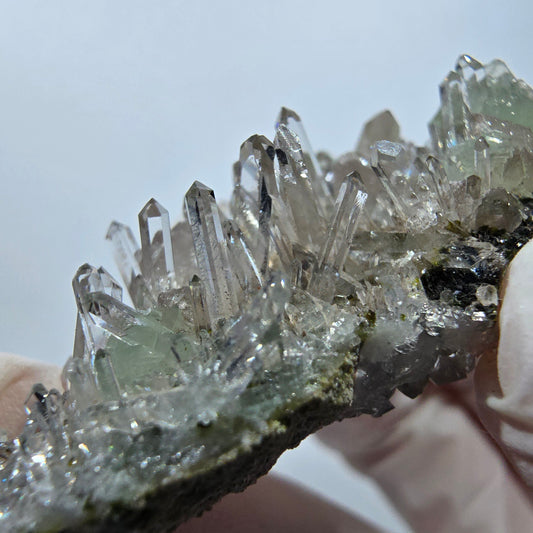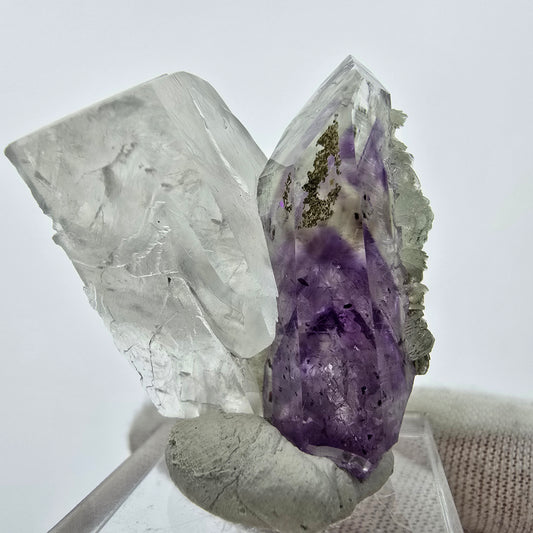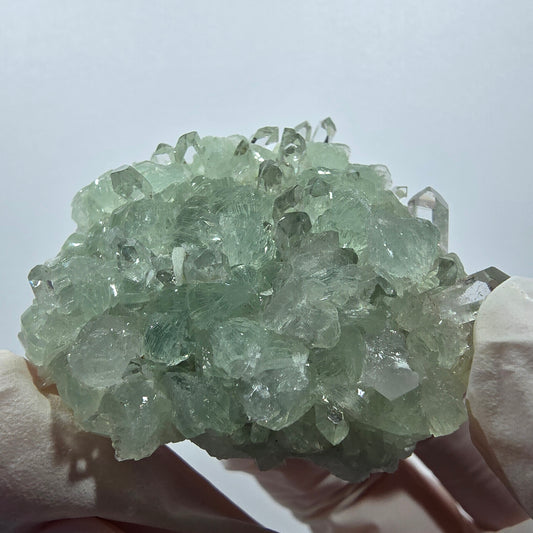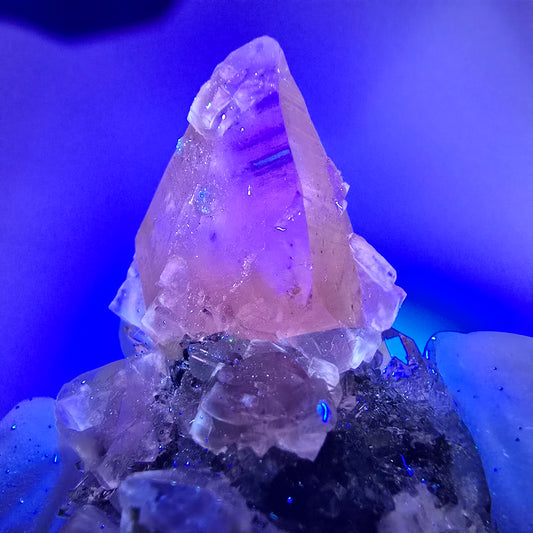-
XL Skeleton Phantom Smoky Quartz DT Scepter, UV Calcite Valentine Pocket, Namibia 191*60*51mm
Regular price €158,90 EURRegular priceUnit price / per -
Harlequin Smoky Quartz, UV Calcite Specimen Valentine Pocket Goboboseb Namibia 79*63*34mm
Regular price €157,49 EURRegular priceUnit price / per -
Enhydro Skeleton Smoky Quartz Scepter UV Calcite 3x Bubble Valentine Pocket, Namibia 149*71*52mm
Regular price €145,90 EURRegular priceUnit price / per -


Enhydro Skeleton Smoky Quartz DT, UV Calcite, 3x Bubble Valentine Pocket Namibia 121*76*35mm
Regular price €142,39 EURRegular priceUnit price / per -
XL Phantom Smoky Quartz DT, UV Calcite on Matrix Valentine Pocket, Namibia 166*81*47mm
Regular price €130,90 EURRegular priceUnit price / per -


Harlequin DT Smoky Quartz, UV Calcite, Chrysocolla Specimen Valentine Pocket Namibia 108*64*44mm
Regular price €129,90 EURRegular priceUnit price / per -
Enhydro Hematite Amethyst Scepter, UV Calcite Streep Mine, Namibia 81*22*21mm
Regular price €125,09 EURRegular priceUnit price / per -


Harlequin Phantom Amethyst, UV Calcite on Matrix Valentine Pocket Gobob. Namibia 78*65*46mm
Regular price €111,99 EURRegular priceUnit price / per -


Skeleton Smoky Quartz Scepter, UV Calcite Specimen Valentine Pocket Goboboseb Namibia 117*60*59mm
Regular price €109,90 EURRegular priceUnit price / per -
Enhydro Skeleton Smoky Quartz Scepter, UV Calcite Valentine Pocket Goboboseb Namibia 99*56*45mm
Regular price €92,90 EURRegular priceUnit price / per -


Enhydro Hematite Smoky Quartz, Calcite Matrix, 3x Bubble Valentine Pocket, Namibia 58*46*29mm
Regular price €92,90 EURRegular priceUnit price / per -
XL Enhydro Skeleton Smoky Quartz DT, UV Calcite, 2x Bubble Valentine Pocket Namibia 165*56*45mm
Regular price €90,90 EURRegular priceUnit price / per -


Enhydro Skeleton Amethyst DT Scepter, Calcite Valentine Pocket Goboboseb Namibia 100*36*30mm
Regular price €89,69 EURRegular priceUnit price / per -
Skeleton Phantom Smoky Quartz DT Scepter, UV Calcite Valentine Pocket, Namibia 82*38*26mm
Regular price €88,29 EURRegular priceUnit price / per -
Lemurian Phantom Skeleton Smoky Quartz DT, UV Calcite Valentine Pocket, Namibia 129*61*48mm
Regular price €87,90 EURRegular priceUnit price / per -
Enhydro Skeleton Smoky Quartz DT Scepter, UV Calcite Valentine Pocket, Namibia 153*62*39mm
Regular price €83,90 EURRegular priceUnit price / per -
Starburst Quartz, Prehnite, Analcim, Calcite Streep Mine, Gobo., Namibia 51*36*20mm
Regular price €79,90 EURRegular priceUnit price / per -
Enhydro Skeleton Amethyst DT Scepter UV Calcite 2x Bubble Valentine Pocket Namibia 106*35*26mm
Regular price €79,90 EURRegular priceUnit price / per -
Enhydro Skeleton Smoky Quartz DT UV Calcite, large bubble Valentine Pocket Namibia 134*45*37mm
Regular price €71,90 EURRegular priceUnit price / per -
Rare UV Calcite specimen Valentine Pocket Mine, Goboboseb, Namibia 88*44*29mm
Regular price €70,90 EURRegular priceUnit price / per -
Enhydro Skeleton Amethyst DT Scepter UV Calcite 2x Bubble Valentine Pocket Namibia 99*35*31mm
Regular price €68,90 EURRegular priceUnit price / per -


Phantom Smoky Quartz DT, UV Calcite on Matrix Specimen Valentine Pocket, Namibia 67*44*24mm
Regular price €67,90 EURRegular priceUnit price / per -
Enhydro Harlequin Amethyst Prehnite UV Calcite Streep Mine Gobo. Namibia 37*31*19mm
Regular price €66,29 EURRegular priceUnit price / per -
Starburst Quartz, Prehnite, Calcite Specimen Streep Mine, Goboboseb Namibia 44*40*16mm
Regular price €64,90 EURRegular priceUnit price / per -
Enhydro Skeleton Smoky Quartz DT, UV Calcite, 2x Bubble Valentine Pocket, Namibia 105*38*32mm
Regular price €62,90 EURRegular priceUnit price / per -
Enhydro Skeleton Smoky Quartz DT, UV Calcite, 3x Bubble Valentine Pocket, Namibia 118*34*29mm
Regular price €61,90 EURRegular priceUnit price / per -
Lemurian Phantom Skeleton Smoky Quartz DT, UV Calcite Valentine Pocket, Namibia 133*46*36mm
Regular price €57,90 EURRegular priceUnit price / per -
Enhydro Phantom Skeleton Smoky Quartz DT, UV Calcite Valentine Pocket Gob. Namibia 107*41*27mm
Regular price €57,90 EURRegular priceUnit price / per -
Phantom Amethyst Hematite Calcite Prehnite Specimen Streep Mine Namibia 50*45*25mm
Regular price €52,90 EURRegular priceUnit price / per -
Skeleton Phantom Smoky Quartz DT Scepter, UV Calcite Valentine Pocket, Namibia 89*47*32mm
Regular price €52,90 EURRegular priceUnit price / per -
Hematite Phantom Smoky Quartz, UV Calcite on Matrix Valentine Pocket Gob. Namibia 82*57*53mm
Regular price €52,90 EURRegular priceUnit price / per -
Skeleton Smoky Quartz DT Scepter, UV Calcite Valentine Pocket, Namibia 101*64*52mm
Regular price €51,90 EURRegular priceUnit price / per -
Enhydro Lemurian Hematite Smoky Quartz UV Calcite Matrix Valentine Pocket, Namibia 86*52*39mm
Regular price €51,90 EURRegular priceUnit price / per -
Clear quartz, prehnite, calcite specimen Streep Mine, Goboboseb, Namibia 49*38*23mm
Regular price €50,90 EURRegular priceUnit price / per -
Rare UV Calcite, Prehnite Specimen Streep Mine, Goboboseb, Namibia 44*34*20mm
Regular price €50,90 EURRegular priceUnit price / per -


Phantom Smoky Quartz DT, UV Calcite on Matrix Specimen Valentine Pocket, Namibia 86*60*34mm
Regular price €49,90 EURRegular priceUnit price / per
Collection: Calcite
Discover the fascinating world of calcite
Calcite is one of the most common minerals on our planet and is a favorite not only of geologists but also collectors and gemstone lovers. In this blog post, we take a look at the general properties of calcite, its origin and care.
Origin of the name
The name "calcite" comes from the Latin word "calx", which means "lime". This refers to the chemical composition of the mineral, which consists mainly of calcium carbonate (CaCO₃). Calcites are not only important in mineralogy, but also in the construction industry, as they are a major component of limestone and marble.
Occurrence and appearance
Calcite is an extremely common mineral that occurs in a variety of geological environments. It is often found in sedimentary rocks, igneous rocks and metamorphic rocks. The most famous locations include the Alps, Mexico, the USA and Brazil.
In terms of appearance, calcite can occur in a variety of colors, including clear, white, yellow, orange, green, blue, and even red. The crystals are often transparent to translucent and exhibit pronounced cleavage. Typical crystal shapes are rhombohedral, prismatic, or tabular.
Chemical composition and hardness
Calcite is composed of calcium carbonate (CaCO₃) and has a Mohs hardness of 3, meaning it is relatively soft. This property makes it easy to work with, but also susceptible to scratches and damage.
Crystal forms and varieties
Calcite occurs in various crystal forms, including rhombohedral, prismatic and tabular crystals. There are also numerous varieties, such as the famous aragonite, which has a different crystal structure but is also made of calcium carbonate. Other interesting varieties are manganese calcite, which is pink to red in color due to its high manganese content, and spar, which is often used in the construction industry.
Care of Calcite
To preserve the beauty and integrity of calcite, careful care is important. Here are some tips:
1. Cleaning : Use a soft, damp cloth to remove dust and dirt. Avoid using aggressive cleaning products or chemical substances as these may damage the surface.
2. Storage : Store Calcite in a safe place, away from other minerals to avoid scratches. A collector's box with soft compartments is ideal.
3. Avoid heat and humidity : Calcites are sensitive to extreme temperatures and humidity. Keep them in a cool, dry place.
Calcite is a fascinating mineral that impresses not only with its beauty but also with its versatility. Whether as a piece of jewelry, in interior design or as a collector's item - calcites are a wonderful addition to any mineral lover. Visit our online shop to discover a selection of high-quality calcites!








































































